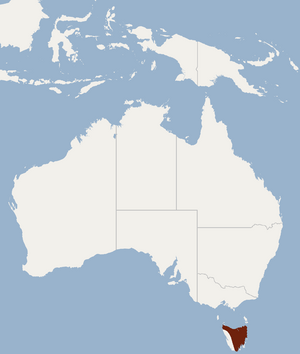Tasmanian long-eared bat facts for kids
Quick facts for kids Tasmanian long-eared bat |
|
|---|---|
| Conservation status | |
| Scientific classification | |
| Genus: |
Nyctophilus
|
| Species: |
sherrini
|
 |
|
| Range map | |
The Tasmanian long-eared bat (Nyctophilus sherrini) is a special type of bat. It lives only on the island of Tasmania, which is part of Australia. This bat is known for its long ears, which help it hear very well. It belongs to a group called vesper bats.
Contents
About Its Name and Family
How It Got Its Scientific Name
This bat was first officially described in 1915 by a British scientist named Oldfield Thomas. He gave it the scientific name Nyctophilus sherrini. The part "sherrini" was chosen to honor a person named William Robert Sherrin. Mr. Sherrin helped many scientists at the British Museum by preparing tiny animal parts for study. Thomas wrote that Sherrin's work was very helpful.
For a long time, some scientists thought this bat was the same as another bat, the greater long-eared bat. But around 2009, they realized it was a unique species on its own.
What Does It Look Like?
Size and Features
The Tasmanian long-eared bat has some special features that help scientists tell it apart from other bats in the Nyctophilus group. It is a large bat with a narrow skull. Its third molars (back teeth) are also larger than those of similar bats.
This bat has a narrow snout (nose area) and a wide braincase (the part of the skull that holds the brain). It also has fairly large auditory bullae, which are bony structures around its ears.
Measurements
The forearm of this bat is about 44.3 to 46.4 millimeters (about 1.7 to 1.8 inches) long. An adult bat usually weighs between 9.8 and 18.9 grams (about 0.3 to 0.7 ounces). Its ears are quite large compared to its body, measuring about 27.2 to 29.8 millimeters (about 1.1 to 1.2 inches) long.
Like many mammals, bats have a specific number of teeth. The Tasmanian long-eared bat has a total of 30 teeth.
Where It Lives and Its Home
Geographic Range
The Tasmanian long-eared bat can be found all over Tasmania. The IUCN, a group that studies wildlife, says it is not found in the southwestern part of Tasmania. However, some researchers believe it does live in the coastal southwest, even though it's rarely seen there.
Habitat
This bat prefers to live in forests. These forests provide the perfect environment for it to find food and shelter.
Protecting This Bat
Conservation Status
As of 2020, the IUCN has listed the Tasmanian long-eared bat as a vulnerable species. This means it is at risk of becoming endangered if its population continues to decline.
Why It's Vulnerable
Scientists don't have enough information to know exactly how many of these bats there are or how far they spread across Tasmania. However, it seems that the number of Tasmanian long-eared bats is decreasing. This makes it important to protect their forest homes and learn more about them to help them survive.
See also



